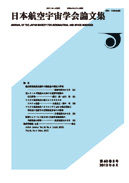All issues

Volume 60 (2012)
- Issue 6 Pages 213-
- Issue 5 Pages 181-
- Issue 4 Pages 149-
- Issue 3 Pages 115-
- Issue 2 Pages 65-
- Issue 1 Pages 1-
Volume 60, Issue 6
Displaying 1-4 of 4 articles from this issue
- |<
- <
- 1
- >
- >|
Articles
-
Phongsatorn SAISUTJARIT, Shinichi NAKASUKA2012 Volume 60 Issue 6 Pages 213-220
Published: 2012
Released on J-STAGE: June 27, 2014
JOURNAL FREE ACCESSThis paper describes a concept of Multi-Tethered-Robot (MTR) on spinning Furoshiki-Satellite System (FSS). The concept is expected to be applied for automation of on-orbit construction of FSS. Transition of MTR to any arbitrary target point on the net surface, can be achieved by simultaneously controlling the tethers connected between the robot and the corner-fixed satellites (CFS). Due to the flexibility of the net and unfixed CFSs, many constrains make control of MTR more comlex than those of the end-tip-fixed system. This paper investigates the feasibility of MTR system through numerical simulations using descrete mass model (flexibility model). PID controller is introduced to implement control of the length and tension of tethers under the constrains.View full abstractDownload PDF (1254K) -
Takeyasu SAKAI2012 Volume 60 Issue 6 Pages 221-226
Published: 2012
Released on J-STAGE: June 27, 2014
JOURNAL FREE ACCESSThe Quasi-Zenith Satellite System (QZSS) has been developed by Japan as a regional navigation satellite system covering Japanese territory and the surrounding region. The most distinguished property of the QZSS is broadcast of radiosignals from a high elevation angle to users, which improves availability of position fixes even in urban canyons and mountainous area. It is, however, a potential problem that a fail of QZSS satellite degrades this property largely because the QZSS consists of the relatively small number of satellites. The author investigated a recovery method from such a situation by relocation of satellites adjacent to the failed satellite. According to the computational results for the constellations of three to five satellites, the minimum elevation angle of the system could be improved by the relocation by about 20 degrees with change of orbital planes and by 6 to 10 degrees even if orbital planes are not changed.View full abstractDownload PDF (1310K) -
Takeshi YAMASAKI, Hiroyuki TAKANO, Isao YAMAGUCHI2012 Volume 60 Issue 6 Pages 227-234
Published: 2012
Released on J-STAGE: June 27, 2014
JOURNAL FREE ACCESSThis study focuses on guidance for uninhabited aerial vehicles (UAVs) conducting a coordinated standoff flight around some pre-specified area or a point. A guidance law for a single standoff-flying-UAV is proposed, first. Although the proposed guidance law is simple, it can incorporate desired properties such that the UAV orients to the target point when the UAV approaches far from the target point, whereas the UAV conducts standoff flight as the UAV comes close to the target point. A guidance law for multiple UAVs should take account of avoiding collision with other UAVs. For this purpose, a concept of decentralized control is introduced where the guidance law for multiple UAVs can be developed by adding a simple term to the guidance law for a single standoff-flying-UAV. Potential of the novel guidance laws for a single UAV and multiple UAVs are performed with some coordinated standoff flight simulations.View full abstractDownload PDF (897K)
Notes
-
Reiji KOMATSU, Toshikazu YAMAGUCHI, Yasuhisa ODA, Shohei SAITOH, Masaf ...2012 Volume 60 Issue 6 Pages 235-237
Published: 2012
Released on J-STAGE: June 27, 2014
JOURNAL FREE ACCESSMicrowave Rocket is considered to be a future mass transportation system to space. Thrust is generated by high-pressure air isometrically heated by millimeter wave irradiation from the ground. High-power and high-frequency operation has been achieved mainly because of the improvement of a millimeter wave generator, gyrotron. Thrust was measured in a high-duty-cycle condition with a high-power millimeter wave. As a result, 30 N of time-averaged thrust was recorded at 91 kW of time-averaged power, which corresponds to 330 N/MW of thrust-to-power ratio.View full abstractDownload PDF (474K)
- |<
- <
- 1
- >
- >|